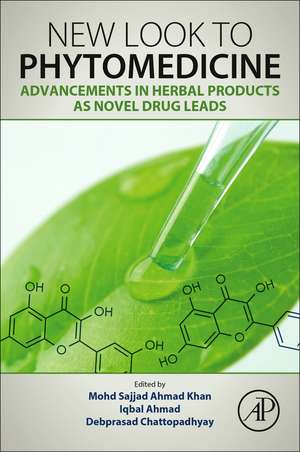New Look to Phytomedicine: Advancements in Herbal Products as Novel Drug Leads
Editat de Mohd Sajjad Ahmad Khan, Iqbal Ahmad, Debprasad Chattopadhyayen Limba Engleză Paperback – 26 oct 2018
Step-by-step information is presented on chemistry, bioactivity and the functional aspects of biologically active compounds. In addition, the pharmacognosy of plant products with mechanistic descriptions of their actions, including pathogenicity is updated with information on the use of nanotechnology and molecular tools in relation to herbal drug research.
- Compiles up-to-date information on the chemotherapeutics used in the treatment of infective and metabolic disorders
- Presents advancements in the discovery of new drugs from plants using molecular and nanotechnology tools
- Examines detailed information on the use of herbals agents in cancer, HIV and other ailments, including diabetes, malaria and neurological disorders
Preț: 832.83 lei
Preț vechi: 1102.14 lei
-24% Nou
Puncte Express: 1249
Preț estimativ în valută:
159.38€ • 164.65$ • 132.65£
159.38€ • 164.65$ • 132.65£
Carte tipărită la comandă
Livrare economică 19 martie-02 aprilie
Preluare comenzi: 021 569.72.76
Specificații
ISBN-13: 9780128146194
ISBN-10: 0128146192
Pagini: 710
Dimensiuni: 152 x 229 mm
Greutate: 0.57 kg
Editura: ELSEVIER SCIENCE
ISBN-10: 0128146192
Pagini: 710
Dimensiuni: 152 x 229 mm
Greutate: 0.57 kg
Editura: ELSEVIER SCIENCE
Public țintă
Researchers in the Pharmaceutical industry, Medicinal Chemistry, Natural Drug Discovery, Practitioners of traditional medicines, Ayurveda, Unani and Alternative medicines will also benefit from this work.Cuprins
Section 1: Introduction to Herbal Therapeutics
1. Herbal Medicine: Current trends and future prospects
2. Diversity of bio-active compounds and their therapeutic potential
3. Ethnomedicinal wisdom: An approach for antiviral drug development
4. Plant derived prebiotics and its health benefits
Section 2a: Biological activity and discovery of new compounds from herbs, medicinal plants and herbal medicine
5. Moroccan medicinal plants as anti-infective and antioxidant agents
6. Anti-inflammatory properties of herbs in oral infection
7.Bioactive molecules, pharmacology and future research trends of Ganoderma lucidium as a cancer chemotherapeutic agent
8. Indian berries and its active compounds: therapeutic potential in cancer prevention
9. Prospects of essential oils in controlling pathogenic biofilm
10. Anticancer phytocompounds: Experimental and clinical updates
11. Plant derived molecules in managing HIV infection
Section 2b: Mechanism of action plant derived products/medicine
12. Current Strategy to target bacterial quorum sensing and virulence by phytocompounds
13. Understanding biochemical and molecular mechanism of complications of glycation and its management by herbal medicine
14. Insights of Phyto-compounds as anti-pathogenic agents: Controlling strategies for inhibiting biofilms and quorum sensing in Candida albicans
15. Neem Leaf Glycoprotein in Cancer Immunomodulation and Immunotherapy
16. Role of phytomedicine in diabetes and cardiovascular diseases
17. Plant-derived Immuno-modulators
Section 3: Pharmacokinetics, interaction and toxicity profile of phytocompounds
18. Herb and modern drug interactions: Efficacy, quality and safety aspects
Section 4: New dimensions in phytotherapy research and applications
19. High Throughput Virtual Screening (HTVS) of natural compounds & exploration of their Bio-molecular mechanisms: An in silico approach
20. Plant extracts and phytocompounds in management of Malaria
21. Assessment of antimicrobial activity of different phytochemicals against enteric diseases in different animal models
22. Nanoparticles in Ayurvedic medicine: potential and prospects
23. Nanoparticles-based delivery of phytomedicines: Challenges and opportunities
24. Phytomedicine: A potential alternative medicine in controlling neurological disorders
1. Herbal Medicine: Current trends and future prospects
2. Diversity of bio-active compounds and their therapeutic potential
3. Ethnomedicinal wisdom: An approach for antiviral drug development
4. Plant derived prebiotics and its health benefits
Section 2a: Biological activity and discovery of new compounds from herbs, medicinal plants and herbal medicine
5. Moroccan medicinal plants as anti-infective and antioxidant agents
6. Anti-inflammatory properties of herbs in oral infection
7.Bioactive molecules, pharmacology and future research trends of Ganoderma lucidium as a cancer chemotherapeutic agent
8. Indian berries and its active compounds: therapeutic potential in cancer prevention
9. Prospects of essential oils in controlling pathogenic biofilm
10. Anticancer phytocompounds: Experimental and clinical updates
11. Plant derived molecules in managing HIV infection
Section 2b: Mechanism of action plant derived products/medicine
12. Current Strategy to target bacterial quorum sensing and virulence by phytocompounds
13. Understanding biochemical and molecular mechanism of complications of glycation and its management by herbal medicine
14. Insights of Phyto-compounds as anti-pathogenic agents: Controlling strategies for inhibiting biofilms and quorum sensing in Candida albicans
15. Neem Leaf Glycoprotein in Cancer Immunomodulation and Immunotherapy
16. Role of phytomedicine in diabetes and cardiovascular diseases
17. Plant-derived Immuno-modulators
Section 3: Pharmacokinetics, interaction and toxicity profile of phytocompounds
18. Herb and modern drug interactions: Efficacy, quality and safety aspects
Section 4: New dimensions in phytotherapy research and applications
19. High Throughput Virtual Screening (HTVS) of natural compounds & exploration of their Bio-molecular mechanisms: An in silico approach
20. Plant extracts and phytocompounds in management of Malaria
21. Assessment of antimicrobial activity of different phytochemicals against enteric diseases in different animal models
22. Nanoparticles in Ayurvedic medicine: potential and prospects
23. Nanoparticles-based delivery of phytomedicines: Challenges and opportunities
24. Phytomedicine: A potential alternative medicine in controlling neurological disorders
